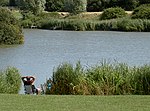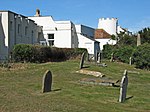Stert Island
Islands of the Bristol ChannelLandforms of SomersetUninhabited islands of England

Stert Island is a low-lying uninhabited island in the Bristol Channel, off the coast of Somerset, England. It lies opposite Burnham-on-Sea, and is part of the Bridgwater Bay Nature Reserve. Stert Island was formed in about 1798, when it broke off from the Steart Peninsula. The island is noted for its birds, including spotted redshank and whimbrel, which have a major night roost on the island.Each year, a 2.4 km (1.5 mi) swim is organised from Burnham-on-Sea to the island.Administratively the island is in the civil parish of Otterhampton. Until 1885 it was in the parish of Stogursey, and from then until 1933 it was in the parish of Huntspill.
Excerpt from the Wikipedia article Stert Island (License: CC BY-SA 3.0, Authors, Images).Stert Island
Geographical coordinates (GPS) Address Nearby Places Show on map
Geographical coordinates (GPS)
| Latitude | Longitude |
|---|---|
| N 51.2263 ° | E -3.0156 ° |
Address
Otterhampton
England, United Kingdom
Open on Google Maps










